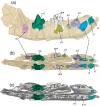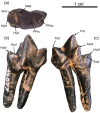New data on the mammalian fauna from the late middle Eocene (MP 15-16) of Mazaterón (Soria, Spain): The youngest presence of the genus Prodissopsalis (Hyaenodonta, Hyaenodontidae) in Europe
- PMID: 37060198
- PMCID: PMC12062567
- DOI: 10.1002/ar.25223
New data on the mammalian fauna from the late middle Eocene (MP 15-16) of Mazaterón (Soria, Spain): The youngest presence of the genus Prodissopsalis (Hyaenodonta, Hyaenodontidae) in Europe
Abstract
The Hyaenodonta were the most diverse carnivorous mammals in the European Eocene and were classically divided into three subfamilies: Sinopaninae, Arfianinae, and Proviverrinae, with this latter being the most successful of the three, as it exhibited a much larger geographic and temporal range. This classification is currently abandoned, as cladistic analyses of Hyaenodonta showed that several of these groups were paraphyletic. In any case, the former "proviverrines" were European endemic hyaenodontids which occupied the niche of small to medium-sized predators from the Ypresian (MP7) to the Priabonian (MP19). Recent phylogenetic proposals recognize the "Eurotherium clade" including this latter genus, besides Cartierodon and Prodissopsalis. A single species is known for Prodissopsalis, Prodissopsalis eocaenicus, previously recorded in European fossil sites of MP 12 to MP 14; nevertheless, the new material studied here, a mandible of a subadult individual from the late Middle Eocene (Bartonian, MP 15-16) site of La Solana (Mazaterón, Soria, Spain) constitutes a new species of Prodissopsalis and the youngest record of this genus up to now, extending its chronological range and remarking the shelter role of the northwestern region of the Iberian Peninsula during the Middle and Late Eocene. The new species, Prodissopsalis jimenezi provides new data not only on the eruption sequence of the genus, but also on the evolution of its dental adaptations, as the new species exhibits a more trenchant, hypercarnivorous dentition in comparison to the more primitive species P. eocaenicus, which would point toward a refining of the hunting abilities of this hyaenodont during the Middle Eocene.
Keywords: Bartonian; Eocene; Hyaenodonta; Spain; endemic faunas.
© 2023 The Authors. The Anatomical Record published by Wiley Periodicals LLC on behalf of American Association for Anatomy.
Figures







Similar articles
-
Hyainailourine and teratodontine cranial material from the late Eocene of Egypt and the application of parsimony and Bayesian methods to the phylogeny and biogeography of Hyaenodonta (Placentalia, Mammalia).PeerJ. 2016 Nov 10;4:e2639. doi: 10.7717/peerj.2639. eCollection 2016. PeerJ. 2016. PMID: 27867761 Free PMC article.
-
Craniodental and humeral morphology of a new species of Masrasector (Teratodontinae, Hyaenodonta, Placentalia) from the late Eocene of Egypt and locomotor diversity in hyaenodonts.PLoS One. 2017 Apr 19;12(4):e0173527. doi: 10.1371/journal.pone.0173527. eCollection 2017. PLoS One. 2017. PMID: 28422967 Free PMC article.
-
First clear evidence of Anoplotherium (Mammalia, Artiodactyla) in the Iberian Peninsula: an update on the Iberian anoplotheriines.Anat Rec (Hoboken). 2025 Jun;308(6):1783-1800. doi: 10.1002/ar.25238. Epub 2023 May 23. Anat Rec (Hoboken). 2025. PMID: 37221992 Free PMC article.
-
Bird evolution in the Eocene: climate change in Europe and a Danish fossil fauna.Biol Rev Camb Philos Soc. 2006 Nov;81(4):483-99. doi: 10.1017/S146479310600707X. Epub 2006 Aug 8. Biol Rev Camb Philos Soc. 2006. PMID: 16893476 Review.
-
The early Eocene birds of the Messel fossil site: a 48 million-year-old bird community adds a temporal perspective to the evolution of tropical avifaunas.Biol Rev Camb Philos Soc. 2017 May;92(2):1174-1188. doi: 10.1111/brv.12274. Epub 2016 Apr 8. Biol Rev Camb Philos Soc. 2017. PMID: 27062331 Review.
References
-
- Aguilar, J.‐P., Agustí, J., Alexeeva, N., Antoine, P.‐O., Telles Antunes, M., Archer, M., Argenti, P., Aubry, M.‐P., Azanza, B., Barbera, Bota, X., Benammi, M., Bendukidze, O., Bernor, R., Bessedik, M., Blondel, C., Boeuf, O., Bolliger, T., de Bonis, L., Brugal, J‐P., et al. (1997). Synthèses et tableaux de corrélations. In J.‐P. Aguilar, S. Legendre, & J. Michaux, (Eds.), Actes du Congrés BiochroM'97, Mémoires et travaux de l'Institut de Montpellier de l'Ecole Pratique HautesEtudes, 21, 769–805.
-
- Alonso‐Gavilán, G. , Armenteros, I. , Carballeire, J. , Corrochano, A. , Huerta, P. , & Rodríguez, J. M. (2004). Cuenca del Duero. In Vera J. A. (Ed.), Geología de España (pp. 550–556). Sociedad Geología de España‐Instituto Geológico y Minero de España.
-
- Badiola, A. (2004). Estudio paleontológico del yacimiento superior de Zambrana (Álava, Región Vasco‐Cantábrica). Tafonomía, Paleobiología de Mamíferos e implicaciones Biocronológicas (Doctoral thesis). Euskal Herriko Unibertsitatea/Universidad del País Vasco.
-
- Badiola, A. , Checa, L. , Cuesta Ruiz‐Colmenares, M. A. , Quer, R. , Hooker, J. J. , & Astibia, H. (2009). The role of new Iberian finds in understanding European Eocene mammalian paleobiogeography. Geologica Acta, 7, 243–258.
-
- Badiola, A. , & Cuesta, M. A. (2008). New endemic Eocene equoids from the Iberian Peninsula (Western Europe). Journal of Vertebrate Paleontology, 28(4), 1149–1161.
MeSH terms
Grants and funding
LinkOut - more resources
Full Text Sources

